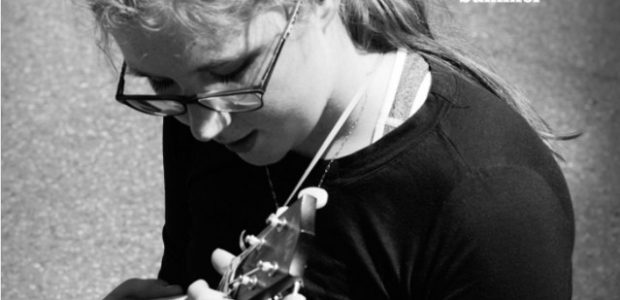This page contains photographic advice, general commentary and snapshots taken during an 8-day whitewater rafting trip down the Colorado River in May of 2000. It is an accompaniment to afeature portfolioof photographs taken during that trip.
Getting Psyched
As the trip drew closer I became more and more concerned about what to bring. Camping and river gear was straightforward. Some the trip organizers supplied, while the rest I either already owned or was purchased from a local outfitter. What caused me considerable head-scratching though was what photographic equipment to pack.
The constraints where several. A river rafting trip is extremely wet and therefore all camera gear had to fit in a hard-sided waterproof case. Also, we’d be spending a lot of time hiking within the canyons and so a backpack type camera case was a must. Mutually contradictory requirements.
Though a process of elimination, and given the space constraints on the raft for camera gear as well as our dry bags and wet bags, I selected aDoskocil(Pelican type) waterproof case. After removing all of the foam I found that aLowePro MiniTreckercamera backpack would fit inside nicely while fully loaded.
This set-up proved to be ideal, though in truth I almost never wore the backpack. The heat, and the difficulty of the hikes and climbs undertaken made this unpleasant at best. Instead I wore myDomkeshooting vest and loaded up the pockets with extra lenses film, and filters. This turned out to work reasonably well, but had the problem of exposing film and lenses to water and knocks.
Selecting Cameras and Lenses
When doing landscape photography I usually shoot medium format‚ a Rollei 6008 system. I rejected this for two main reasons. The Rollei can only use rechargeable nicad batteries. With 8 days away from the nearest electrical outlet, and the likelihood that I could shoot as many as 200 rolls of 120 film, even the 3 batteries I own didn’t seem enough. Also, while the Rollei system has proven itself quite rugged on a number of shoots, I have found that it doesn’t like getting really wet. On a shoot inZion National Parka few years ago the camera died for several hours after becoming heavily soaked in a spring rain.
Since large-format was out of the question because of size and working-speed constraints, 35mm was therefore the obvious selection. Fortunately a newCanon EOS-1Vbody had arrived just a few weeks before departure. According to Canon this body is extremely water resistant with 37 rubber gasket seals on all body entrances. If anything could survive the rigors of this trip theIVwould likely be it.
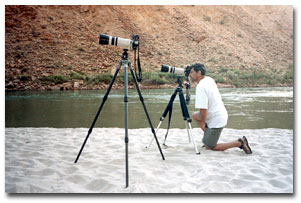 Steve Kossack‚ burning film
Steve Kossack‚ burning film
At first I also packed anEOS-3body as a backup. No way would I trust a single body on a rugged trip of this nature. Then, because I started to miss the quality advantages of medium format I decided to take along theHasselblad XPan. But now, the MiniTrecker was nowhere near big enough for three bodies and 8 lenses.
In the end, here’s what I picked and packed:
Canon EOS-1V body
Canon 24 T/S, 28~70mm zoom, 100~400mm Image Stabilized zoom
Hasselblad XPan body
Hasselblad 30mm, 45mm and 90mm lenses
This gave me two separate camera systems, each with 3 lenses. It would cover everything from panoramic format with wide, normal and slight-tele lenses with the Hasselblad‚ at medium format quality, to medium-wide to long-tele with the Canon system. While I was nervous at not having a back-up Canon body the fact that my friend Steve Kossack would have an extra one along meant that I wouldn’t be completely in the lurch if the EOS 1V failed for any reason.
I bought as well a wide range of filters, including polarizers and split NDs, along with holders and adaptors for all lenses. My tripod was theGitzo 1349carbon fiber withArca Swiss B1ball head. I removed the center column to reduce weight and increase stability.
For film I brought along 60 rolls ofFuji Provia 100F. Enough I hoped for 8 days of shooting in one of the worlds most awesome landscapes.
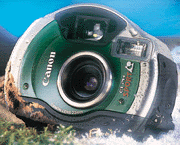
Finally, I purchased aCanon Elf Sport, a very small and elegant waterproof APS camera. This turned out to be ideal for snapshots both on and off the rafts. Most of the snapshots on this page were taken with it.
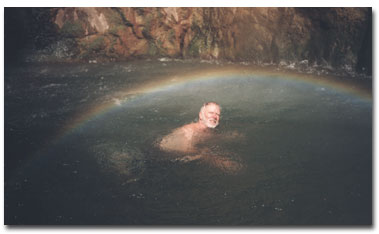 George Perkins ‚ Swimming beneath the rainbow at Deer Creek Falls
George Perkins ‚ Swimming beneath the rainbow at Deer Creek Falls
What Worked & What Didn’t?
The newEOS-1Vcame through with flying colours. Sand and water didn’t phase it. Steve Kossack’s older Canon A2E took a swim and survived, but a digital audio recorder that I was using to make shooting notes got slightly damp one day and bit the dust. I lost 5 days worth of notes! Other than that, no equipment casualties were seen. I’ve been told that on many trips so many cameras are destroyed by water and sand that they hold a funeral ceremony for them on the last day. Our group was luckier than that.
My lens choice also turned out to be ideal. The100~400mm IS zoomwas perfect for wildlife as well as passing details from the raft as we drifted and motored down the river. The24mm Tilt/Shiftlens proved to be the ideal lens for both broad landscapes and detail work in the steep canyons, while the28~85mm zoomfilled in the rest of the range.
TheXPanshould have stayed at home. I had thought that given the nature of the Grand Canyon a panoramic camera system would be ideal. What I had misjudged was that while the canyon is panoramic from the top, once inside the real photographic opportunities are quite different in perspective. I would have been better off devoting the space that the XPan and its 3 lenses took to bringing along the17~35mm zoomand a flash, both of which I really missed.
Also, I missed having thePB-E2power base on the 1V. I had removed it thinking that the reduced bulk and weight would help, but instead I really missed having both the vertical release and the high speed motor drive for shots of rafts going through the rapids and for wildlife. Next time.
TheElf Sportwas great fun to shoot with and I used it extensively for snapshots both on the river and at camp. Almost all of the shots on this page were taken with the Sport. There were also several waterfalls where being able to play around with a waterproof camera proved to be great fun.
Polarizer Vs. Film Speed
A polarizing filter is a must in this environment. In addition to the usual task of darkening the sky it’s extremely useful in reducing glare and reflections from rock walls and stream beds. The challenge though is in the trade-off between film speed and the 1.5 stop light-loss that the polarizer dictates. Using ISO 100 speed film I constantly found myself on the edge of acceptable shutter speeds when shooting hand-held from the moving raft. The use of the Canon 100~400mm Image Stabilized lens though made ahugedifference in my ability to get usable images as we made our way down the river.
I haven’t indicated so explicitly but virtually every photograph in myGrand Canyon Portfoliowas taken with a polarizer.
Film
During the 8 day of the trip I shot a total of 47 rolls of 135-36, and 5 rolls of 40 exposure APS. To save you doing the math, this is almost 2000 frames! At least 4 of these rolls were high-speed (3 FPS) bursts done while the other boat was shooting various rapids. As I’ve mentioned elsewhere, I wish I’d brought along the PB-E2 power base for the EOS-1V since I would have liked to have faster burst speeds available. Nevertheless, a full roll every 10 seconds does take its toll on ones film supply.
Also, for many scenes shot from the moving raft I shot multiple frames, just to be sure of getting one that was not blurred by motion. For tripod-mounted shots there was a great deal of bracketing done due to the harsh desert light, so all-in-all my guess is that there were some 200 unique "set-ups" attempted with those 50-odd rolls.
Packing and Non-Photo Gear
I brought too much stuff. So did almost everyone else. It turned out that all that’s really needed are a pair of waterproof hiking sandals and a couple of polyester shirts and shorts. Rinse them out in the river at night and wear them again the next day. Items sold as "river gear" are ideal because they dry almost instantly. Other than that, lots of sun-screen and a broad-brimmed hat are necessities. The hat should have both chin and back-of-head straps as the wind can be high and when shooting the rapids you need both hands to hold on to the boat, not an errant hat. A sturdy rain jacket is also worthwhile in a effort to stay dry through the bigger rapids.
The Rafting Company
We usedGrand Canyon Expeditions. They turned out to be an excellent outfit and I can recommend them highly. They really sweat the details and it showed. This company’s many years of running rafting trips on the Colorado meant that there were no unpleasant surprises.
Safety is always stressed and at no point did any of us feel any sense of danger, largely due to the professionalism if the crew. There are more than 60 rapids encountered on the 270 miles of the the trip, and several of them are amongst the largest rapids found anywhere. While I’m sure that these were a challenge for the boatman, for us passengers they were nothing if not thrilling.
GCExprovides sleeps bags, air mattresses and ground sheets. They also provide dry-bags for holding personal clothing and waterproof ammo cans for holding small items that one needs to get to on the raft during the day.
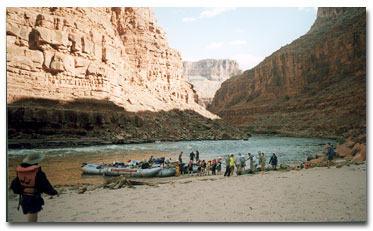 Offloading the boats and setting up camp
Offloading the boats and setting up camp
Meals were excellent camp-style food. Top quality and plentiful. Breakfast consisted of eggs, bacon or sausages, toast and coffee. Teas were available and also a large range of condiments. Lunches were picnic style with deli meats, vegetables and chips. Soft drinks were always available, on and off the rafts, as were apples and oranges. Dinners ranged from spaghetti and meatballs to steak and baked potatoes. No one went hungry.
Our Photography Guide

The photography guide for this trip wasC.C. Lockwood, a talented nature photographer who has run the river more than twenty times, and who has published a book called Beneath The Rim, A Photographic Journey Through the Grand Canyon. CC, as he’s called, is a soft-spoken southerner and he provided many of the trips members with useful photographic advise as well as location commentary.
Choosing a Raft & Where to Sit
Most motorized trips consist of two rafts, each carrying up to 14 people. Because we had chosen a trip which had an emphasis on photography they were very accommodating about tripods and camera cases.
Each raft has a front and a rear seating section separated by a raised area. The rear section is preferable for photographers because the raised platform between them is where waterproof camera cases are strapped. This makes access to your cameras much easier between rapids.
Beneath this platform are trip supplies. One of the rafts carries the bulk of the food, much of which is stowed in this compartment. If you choose the wrong raft this means that every lunch time your equipment needs to be removed for access. So, choose the boat thatdoesn’tcarry the food.
After a couple of days of opening and closing my case frequently to access my camera I started to wrap it in my rain jacket instead and just huged it close to my chest during rapids. This worked much of the time but on the really big rapids there is so much water coming across the deck that even a waterproof jacket couldn’t keep things dry. The EOS-1V got a real soaking a few times but suffered no ill effects
Hiking
Each day there was at least one, and sometimes two major hikes. These lasted from 1 to 3 hours each. They were optional, of course, but were not to be missed. Waterfalls, cataracts, mountain steams, wildlife‚ everything that a landscape and nature photographer could want.
These hikes are difficult, but not impossible. Members of the group ranged from 19 to 70 years of age, and most people were able complete the hikes. Many of them had serious rock scrambling components, and in several places assistance was needed to negotiate especially tough sections. The guides were excellent though and always available to help anyone who needed it.
I would typically carry myEOS-1Vwith28~78mm zoomaround my neck. TheGitzocarbon fiber tripod withArca Swiss B1ball head would be on a sling over my shoulder and the24mm T/Slens along with extra film and filters would go in the pockets of my shooting jacket. (I never carried the 100~400mm zoomon hikes.) Add to this an extra pair of glasses, a digital audio recorder, a bottle of water on a sling strap and various filters and miscellaneous bits and pieces and the load was heavy but manageable.
But, many of the hikes involved wading up riverbeds, sometimes as much as chest deep. This meant ferrying gear back and forth through deep sections by holding them overhead. Between the 100+ degree temperatures and the cold river water this made some of these excursions challenging to say the least.
There are many books that may be of interest to anyone considering this trip. The classic is, of course,John Wesley Powell’s The Exploration of the Colorado River and Its Canyons.
Another isDowncanyon, by naturalistAnn Haymond Zwinger. A poetic account of rafting the canyon in all seasons and the rocks, birds, animals and plants that make the Canyon so much more than a big hole in the ground.
With regard to books of photography, in addition to C.C. Lockwood’sBeneath The Rim, A Photographic Journey Through the Grand Canyonalready mentioned, there is Gary Ladd’sGRANDCANYON, Time Below The Rim
Closing Thoughts
As exciting and enjoyable as the trip was the reality is that it was very much like a bus tour. I travel extensively on photographic shoots and am used to making my own schedules and ensuring that I’m at the best locations in time for the best light.
In this instance each day’s agenda was determined by someone else and each of us was very much governed by both this and the needs of the group as whole. Of the 28 participants less than half a dozen of us were photographers. Concessions were made to our interests and needs but clearly this was a standard rafting trip with just a nodding acceptance to what photographers might require.
Consequently, while it appears that I was able to generate quite a few strong photographs, only a handful will eventually be added to my portfolio. The real issue behind this is the harshness of the light in this environment and our inability to stay at a location until the light was most appropriate. The trade-off is that we were able to visit and photograph some of the most remarkable locations on earth.
By the way, it is possible to do private rafting trips taking up to 30 days, but apparently the waiting list for this is now more than 10 years! If you’re interested in going on a similar trip to the one described be aware that you should try and book as much as a year in advance to get the dates that you want. Spring and fall are best, both in terms of weather and light.
Let me knowif you need any more information.
Michael
You May Also Enjoy...
Sequencing, Part 2
FacebookTweet In these remarks I will try to present a more or less complete example of a book I have made on the Blurb print-on-demand


